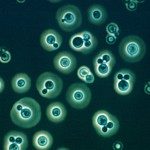Lien vers Pubmed [PMID] – 32284382
Lien DOI – e00070-2010.1128/AAC.00070-20
Antimicrob. Agents Chemother. 2020 06; 64(7):
Brain infections with Cryptococcus neoformans are associated with significant morbidity and mortality. Cryptococcosis typically presents as meningoencephalitis or fungal mass lesions called cryptococcomas. Despite frequent in vitro discoveries of promising novel antifungals, the clinical need for drugs that can more efficiently treat these brain infections remains. A crucial step in drug development is the evaluation of in vivo drug efficacy in animal models. This mainly relies on survival studies or postmortem analyses in large groups of animals, but these techniques only provide information on specific organs of interest at predefined time points. In this proof-of-concept study, we validated the use of noninvasive preclinical imaging to obtain longitudinal information on the therapeutic efficacy of amphotericin B or fluconazole monotherapy in meningoencephalitis and cryptococcoma mouse models. Bioluminescence imaging enabled the rapid in vitro and in vivo evaluation of drug efficacy, while complementary high-resolution anatomical information obtained by magnetic resonance imaging of the brain allowed a precise assessment of the extent of infection and lesion growth rates. We demonstrated a good correlation between both imaging readouts and the fungal burden in various organs. Moreover, we identified potential pitfalls associated with the interpretation of therapeutic efficacy based solely on postmortem studies, demonstrating the added value of this noninvasive dual imaging approach compared to standard mortality curves or fungal load endpoints. This novel preclinical imaging platform provides insights in the dynamic aspects of the therapeutic response and facilitates a more efficient and accurate translation of promising antifungal compounds from bench to bedside.

